Page 415 of 3171
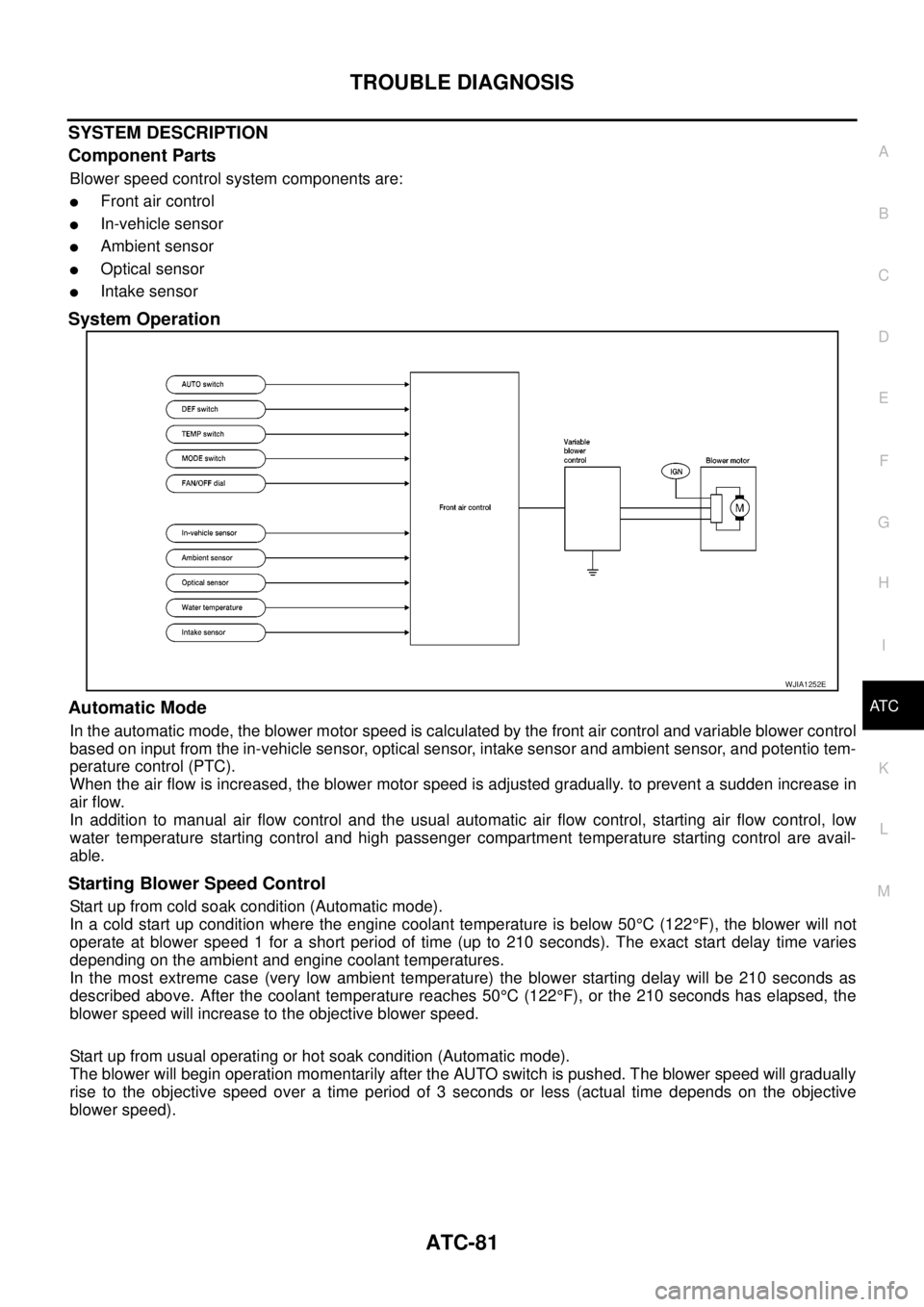
TROUBLE DIAGNOSIS
ATC-81
C
D
E
F
G
H
I
K
L
MA
B
AT C
SYSTEM DESCRIPTION
Component Parts
Blower speed control system components are:
lFront air control
lIn-vehicle sensor
lAmbient sensor
lOptical sensor
lIntake sensor
System Operation
Automatic Mode
In the automatic mode, the blower motor speed is calculated by the front air control and variable blower control
based on input from the in-vehicle sensor, optical sensor, intake sensor and ambient sensor, and potentio tem-
perature control (PTC).
When the air flow is increased, the blower motor speed is adjusted gradually. to prevent a sudden increase in
air flow.
In addition to manual air flow control and the usual automatic air flow control, starting air flow control, low
water temperature starting control and high passenger compartment temperature starting control are avail-
able.
Starting Blower Speed Control
Start up from cold soak condition (Automatic mode).
In a cold start up condition where the engine coolant temperature is below 50°C(122°F), the blower will not
operate at blower speed 1 for a short period of time (up to 210 seconds). The exact start delay time varies
depending on the ambient and engine coolant temperatures.
In the most extreme case (very low ambient temperature) the blower starting delay will be 210 seconds as
described above. After the coolant temperature reaches 50°C(122°F), or the 210 seconds has elapsed, the
blower speed will increase to the objective blower speed.
Start up from usual operating or hot soak condition (Automatic mode).
The blower will begin operation momentarily after the AUTO switch is pushed. The blower speed will gradually
rise to the objective speed over a time period of 3 seconds or less (actual time depends on the objective
blower speed).
WJIA1252E
Page 421 of 3171
TROUBLE DIAGNOSIS
ATC-87
C
D
E
F
G
H
I
K
L
MA
B
AT C
Magnet Clutch CircuitEJS006BQ
SYMPTOM: Magnet clutch does not engage.
INSPECTION FLOW
*1AT C - 5 7 , "Operational Check".*2ATC-55, "A/C System Self-diagnosis
Function".*3AT C - 5 6 , "
SELF-DIAGNOSIS CODE
CHART".
*4ATC-105, "
Ambient Sensor Circuit".*5ATC-114, "Intake Sensor Circuit".
MJIB0348E
Page 422 of 3171
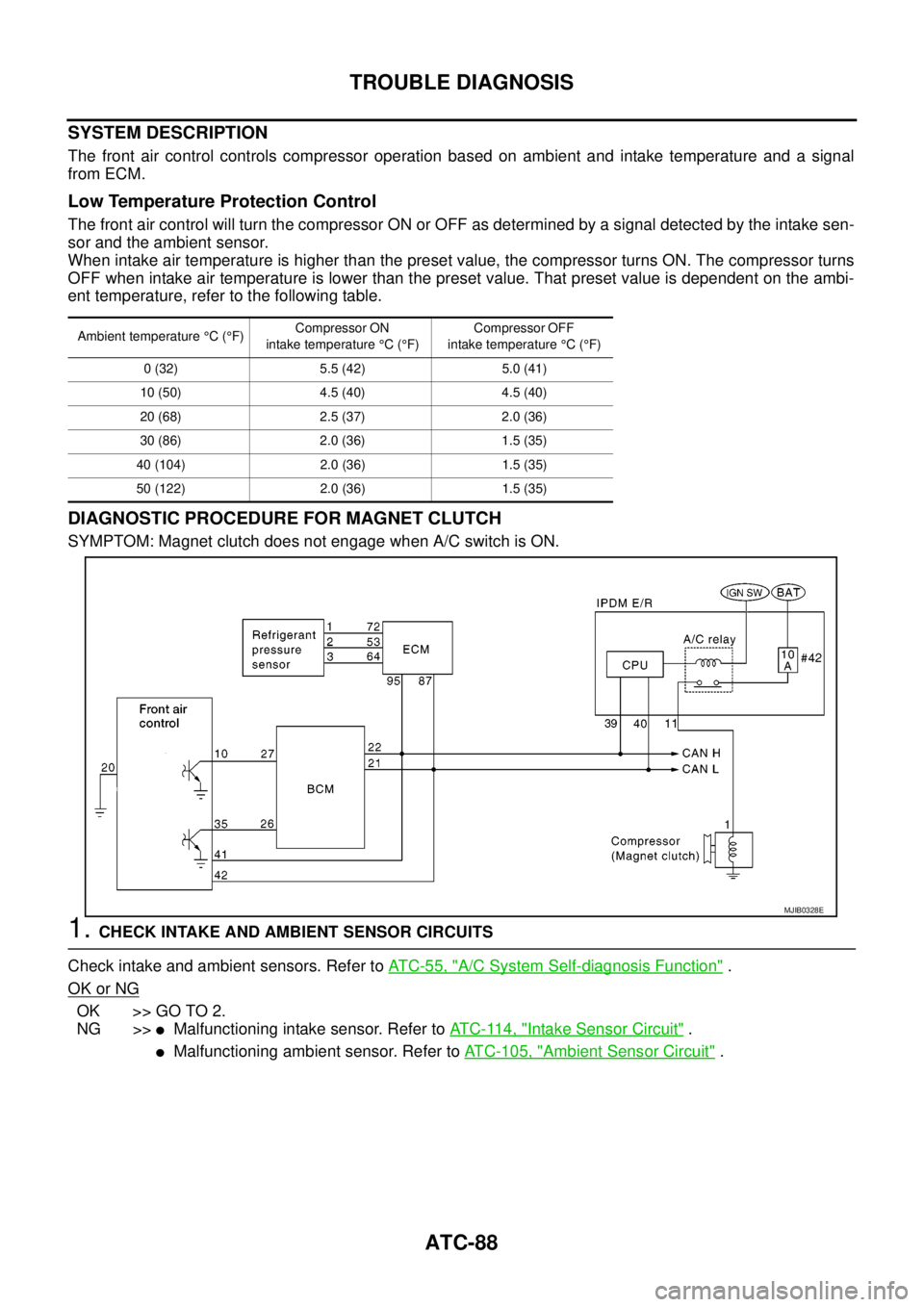
ATC-88
TROUBLE DIAGNOSIS
SYSTEM DESCRIPTION
The front air control controls compressor operation based on ambient and intake temperature and a signal
from ECM.
Low Temperature Protection Control
The front air control will turn the compressor ON or OFF as determined by a signal detected by the intake sen-
sor and the ambient sensor.
When intake air temperature is higher than the preset value, the compressor turns ON. The compressor turns
OFF when intake air temperature is lower than the preset value. That preset value is dependent on the ambi-
ent temperature, refer to the following table.
DIAGNOSTIC PROCEDURE FOR MAGNET CLUTCH
SYMPTOM: Magnet clutch does not engage when A/C switch is ON.
1.CHECK INTAKE AND AMBIENT SENSOR CIRCUITS
Check intake and ambient sensors. Refer toAT C - 5 5 , "
A/C System Self-diagnosis Function".
OK or NG
OK >> GO TO 2.
NG >>
lMalfunctioning intake sensor. Refer toAT C - 11 4 , "Intake Sensor Circuit".
lMalfunctioning ambient sensor. Refer toATC-105, "Ambient Sensor Circuit".
Ambient temperature°C(°F)Compressor ON
intake temperature°C(°F)Compressor OFF
intake temperature°C(°F)
0 (32) 5.5 (42) 5.0 (41)
10 (50) 4.5 (40) 4.5 (40)
20 (68) 2.5 (37) 2.0 (36)
30 (86) 2.0 (36) 1.5 (35)
40 (104) 2.0 (36) 1.5 (35)
50 (122) 2.0 (36) 1.5 (35)
MJIB0328E
Page 425 of 3171
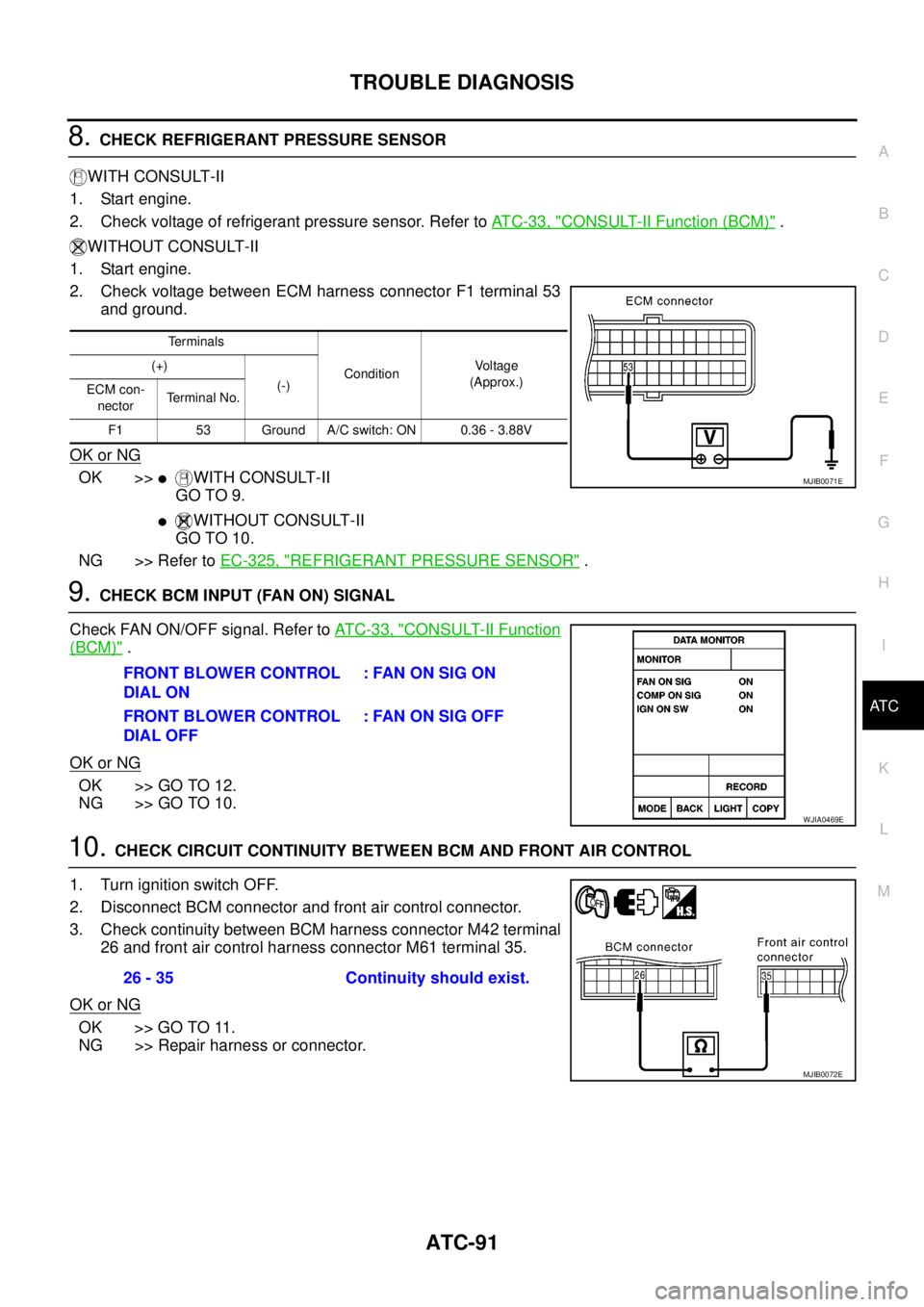
TROUBLE DIAGNOSIS
ATC-91
C
D
E
F
G
H
I
K
L
MA
B
AT C
8.CHECK REFRIGERANT PRESSURE SENSOR
WITH CONSULT-II
1. Start engine.
2. Check voltage of refrigerant pressure sensor. Refer toAT C - 3 3 , "
CONSULT-II Function (BCM)".
WITHOUT CONSULT-II
1. Start engine.
2. Check voltage between ECM harness connector F1 terminal 53
and ground.
OK or NG
OK >>lWITH CONSULT-II
GO TO 9.
lWITHOUT CONSULT-II
GO TO 10.
NG >> Refer toEC-325, "
REFRIGERANT PRESSURE SENSOR".
9.CHECK BCM INPUT (FAN ON) SIGNAL
Check FAN ON/OFF signal. Refer toAT C - 3 3 , "
CONSULT-II Function
(BCM)".
OK or NG
OK >> GO TO 12.
NG >> GO TO 10.
10.CHECK CIRCUIT CONTINUITY BETWEEN BCM AND FRONT AIR CONTROL
1. Turn ignition switch OFF.
2. Disconnect BCM connector and front air control connector.
3. Check continuity between BCM harness connector M42 terminal
26 and front air control harness connector M61 terminal 35.
OK or NG
OK >> GO TO 11.
NG >> Repair harness or connector.
Te r m i n a l s
ConditionVo l ta g e
(Approx.) (+)
(-)
ECM con-
nectorTerminal No.
F1 53 Ground A/C switch: ON 0.36 - 3.88V
MJIB0071E
FRONT BLOWER CONTROL
DIAL ON: FAN ON SIG ON
FRONT BLOWER CONTROL
DIAL OFF:FANONSIGOFF
WJIA0469E
26 - 35 Continuity should exist.
MJIB0072E
Page 426 of 3171
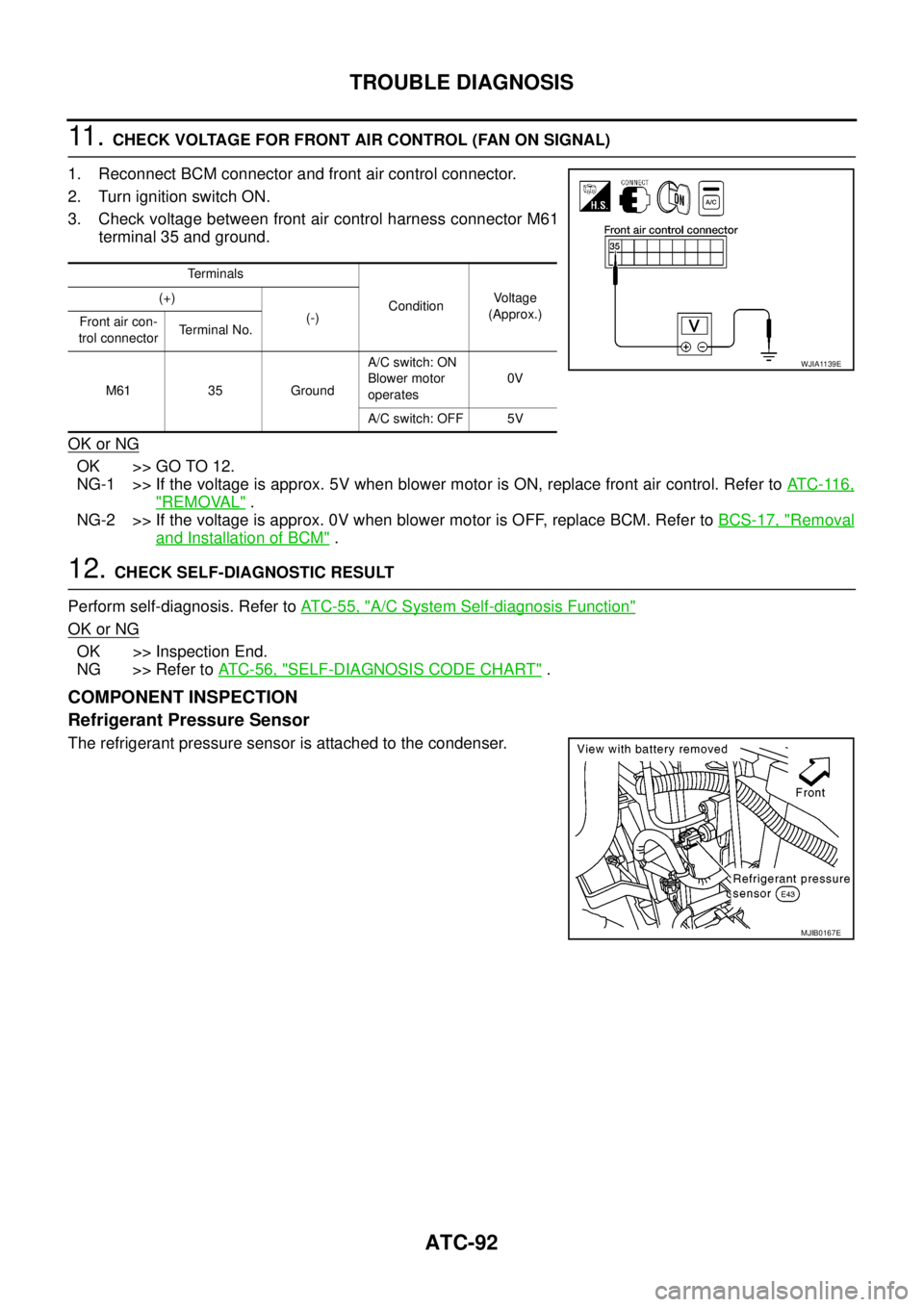
ATC-92
TROUBLE DIAGNOSIS
11 .CHECK VOLTAGE FOR FRONT AIR CONTROL (FAN ON SIGNAL)
1. Reconnect BCM connector and front air control connector.
2. Turn ignition switch ON.
3. Check voltage between front air control harness connector M61
terminal 35 and ground.
OK or NG
OK >> GO TO 12.
NG-1 >> If the voltage is approx. 5V when blower motor is ON, replace front air control. Refer toAT C - 11 6 ,
"REMOVAL".
NG-2 >> If the voltage is approx. 0V when blower motor is OFF, replace BCM. Refer toBCS-17, "
Removal
and Installation of BCM".
12.CHECK SELF-DIAGNOSTIC RESULT
Perform self-diagnosis. Refer toAT C - 5 5 , "
A/C System Self-diagnosis Function"
OK or NG
OK >> Inspection End.
NG >> Refer toAT C - 5 6 , "
SELF-DIAGNOSIS CODE CHART".
COMPONENT INSPECTION
Refrigerant Pressure Sensor
The refrigerant pressure sensor is attached to the condenser.
Terminals
ConditionVoltage
(Approx.) (+)
(-)
Front air con-
trol connectorTerminal No.
M61 35 GroundA/C switch: ON
Blower motor
operates0V
A/C switch: OFF 5V
WJIA1139E
MJIB0167E
Page 432 of 3171
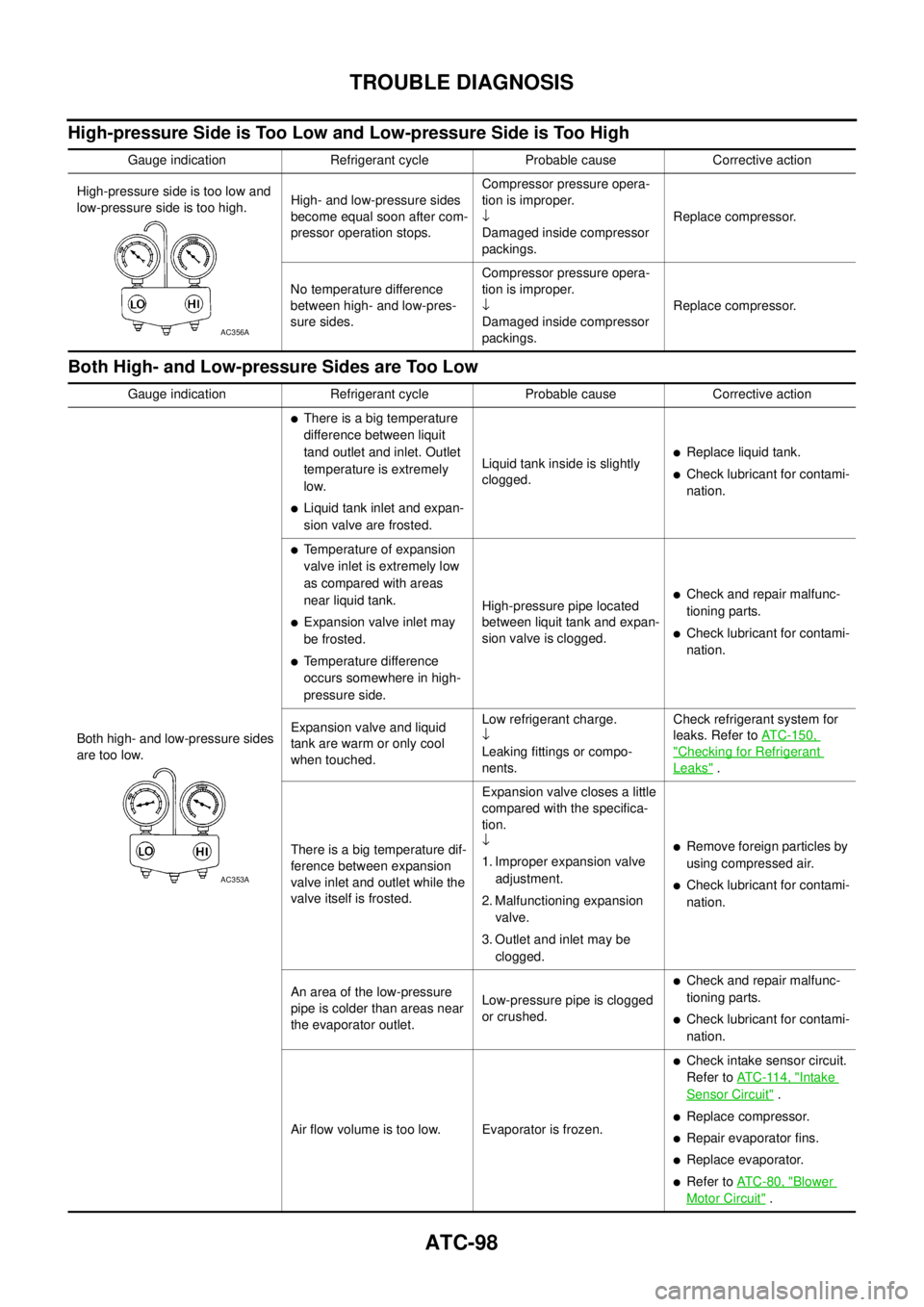
ATC-98
TROUBLE DIAGNOSIS
High-pressure Side is Too Low and Low-pressure Side is Too High
Both High- and Low-pressure Sides are Too Low
Gauge indication Refrigerant cycle Probable cause Corrective action
High-pressure side is too low and
low-pressure side is too high.High- and low-pressure sides
become equal soon after com-
pressor operation stops.Compressor pressure opera-
tion is improper.
¯
Damaged inside compressor
packings.Replace compressor.
No temperature difference
between high- and low-pres-
sure sides.Compressor pressure opera-
tion is improper.
¯
Damaged inside compressor
packings.Replace compressor.
AC356A
Gauge indication Refrigerant cycle Probable cause Corrective action
Both high- and low-pressure sides
are too low.
lThere is a big temperature
difference between liquit
tand outlet and inlet. Outlet
temperature is extremely
low.
lLiquid tank inlet and expan-
sion valve are frosted.Liquid tank inside is slightly
clogged.
lReplace liquid tank.
lCheck lubricant for contami-
nation.
lTemperature of expansion
valve inlet is extremely low
as compared with areas
near liquid tank.
lExpansion valve inlet may
be frosted.
lTemperature difference
occurs somewhere in high-
pressure side.High-pressure pipe located
between liquit tank and expan-
sion valve is clogged.
lCheck and repair malfunc-
tioning parts.
lCheck lubricant for contami-
nation.
Expansion valve and liquid
tank are warm or only cool
when touched.Low refrigerant charge.
¯
Leaking fittings or compo-
nents.Check refrigerant system for
leaks. Refer toATC-150,
"Checking for Refrigerant
Leaks".
There is a big temperature dif-
ference between expansion
valve inlet and outlet while the
valve itself is frosted.Expansion valve closes a little
compared with the specifica-
tion.
¯
1. Improper expansion valve
adjustment.
2. Malfunctioning expansion
valve.
3. Outlet and inlet may be
clogged.
lRemove foreign particles by
using compressed air.
lCheck lubricant for contami-
nation.
An area of the low-pressure
pipe is colder than areas near
the evaporator outlet.Low-pressure pipe is clogged
or crushed.
lCheck and repair malfunc-
tioning parts.
lCheck lubricant for contami-
nation.
Air flow volume is too low. Evaporator is frozen.
lCheck intake sensor circuit.
Refer toAT C - 11 4 , "
Intake
Sensor Circuit".
lReplace compressor.
lRepair evaporator fins.
lReplace evaporator.
lRefer toAT C - 8 0 , "Blower
Motor Circuit".
AC353A
Page 434 of 3171
ATC-100
TROUBLE DIAGNOSIS
Insufficient Heating
EJS006BS
SYMPTOM: Insufficient heating
INSPECTION FLOW
*1ATC-57, "Operational Check".*2AT C - 6 8 , "Air Mix Door Motor Circuit".*3ATC-55, "A/C System Self-diagno-
sis Function".
*4ATC-55, "
A/C System Self-diagnosis
Function".*5AT C - 8 0 , "
Blower Motor Circuit".*6EC-103, "DTC P0117, P0118 ECT
SENSOR".
*7CO-7, "
Changing Engine Coolant".*8CO-13, "Checking Reservoir Tank
Cap".
MJIB0350E
Page 437 of 3171
TROUBLE DIAGNOSIS
ATC-103
C
D
E
F
G
H
I
K
L
MA
B
AT C
Self-diagnosisEJS006BU
SYMPTOM: Self-diagnosis cannot be performed.
INSPECTION FLOW
*1AT C - 6 0 , "Power Supply and Ground
Circuit for Front Air Control".*2ATC-105, "
Ambient Sensor Circuit".*3ATC-108, "In-vehicle Sensor Circuit".
*4AT C - 11 2 , "
Optical Sensor Circuit".*5ATC-114, "Intake Sensor Circuit".*6AT C - 6 8 , "Air Mix Door Motor Circuit".
*7AT C - 5 7 , "
Operational Check".*8ATC-35, "SYMPTOM TABLE".
MJIB0351E